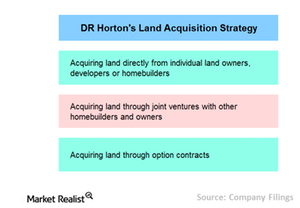Understanding D.R. Horton’s Land Acquisition Strategy
D.R. Horton directly acquires almost all of its land and lot positions. The company has initiated few joint ventures for land acquisitions.
July 21 2015, Published 12:25 p.m. ET

Land acquisition strategies
In this article, we’ll focus on D.R. Horton’s (DHI) land acquisition strategy, as it is an essential element of the company’s entire homebuilding operations. We’ll also see how the company mitigates risk associated with the land acquisition process.
Land trading forms a miniscule part of overall strategy
D.R. Horton (DHI), like other homebuilders such as Lennar (LEN) and KB Homes (KBH), also purchases and develops land, primarily to support its homebuilding activities. However, in some cases, the company also sells land and lots to other developers and homebuilders at a premium in order to create liquidity for the company. The company earned land-trading revenue of $53.8 million in fiscal 2014 compared to $61.1 million in the previous year.
Less dependence on joint ventures
D.R. Horton (DHI) directly acquires almost all of its land and lot positions. The company has initiated few joint ventures for land acquisitions, all of which are consolidated in the financial statements. This is unlike Lennar (LEN), which has large number of joint ventures, many of which are not reflected in the balance sheet.
Option contracts
D.R. Horton also enters into land and lot option contracts, which generally are non-recourse. Under the non-recourse option contracts, the company obtains the right, but generally not the obligation, to buy land or lots at predetermined prices. In such contracts, the company’s exposure is limited only to the extent of deposit paid. If it intends to withdraw from the option contract at any time, it can do so at the expense of deposit. This enables the company to control land and lot positions with limited capital investment, which substantially reduces the risks associated with land ownership and development.
With the onset of the housing recovery, the options contracts as a proportion of total lots controlled has been declining, as the company has written off substantial numbers of options. In addition, land owners are not very enthusiastic to use options, as they can’t sell their land to third parties during the contract period. The maximum they earn during this period is deposit, which is around 10% to 20% of the land value. For land owners, opportunity loss to sell land during this period can be substantial, thus discouraging them further.
Investors looking for diversification in the homebuilding sector can consider ETFs such as the SPDR S&P Homebuilders ETF (XHB) and the iShares Dow Jones US Home Construction Index Fund (ITB).
